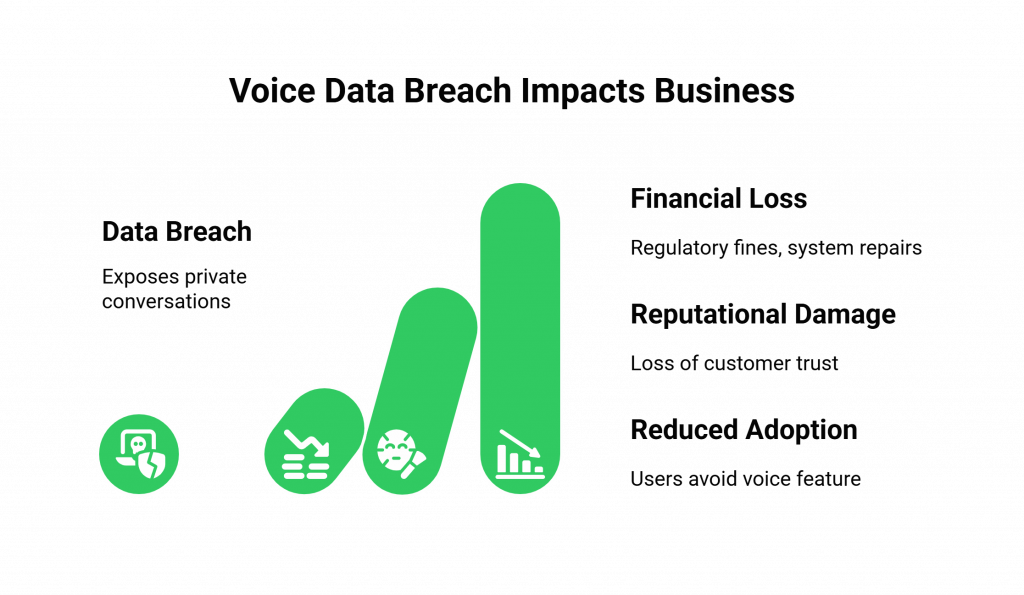For a developer building with voice AI, the live audio stream is everything. It is the raw, digital lifeblood of your application, the data that flows from a human user to your intelligent AI “brain.”
Getting this stream to work in real-time is a significant engineering challenge. But a far more important, and often overlooked, challenge comes first: how do you ensure that this stream remains absolutely, unconditionally secure?
A voice conversation is not just any data. It is one of the most sensitive and personal forms of data in existence. It can contain personally identifiable information (PII), financial details, private health information, and the unique biometric signature of a person’s voice. Streaming this data across the public internet is like sending precious cargo in an unarmored truck down a dangerous highway.
This is why, for any serious developer, security cannot be an afterthought; it must be the foundational principle of your entire voice architecture.
This guide will serve as a security blueprint. We will explore the threat model for real-time audio, dissect the core principles of secure streaming, and provide a clear architectural plan for using a voice API for developers to build an impenetrable, enterprise-grade AI solution.
Table of contents
Why is Securing Voice Data So Critically Important?
In the world of voice AI, a security breach is not just a technical failure; it’s a catastrophic business event. The consequences of failing to protect your users’ voice data are severe and multi-faceted.

What Are the Financial and Reputational Costs of a Breach?
A data breach is one of the most expensive disasters a modern business can face. The costs are not just in regulatory fines, but in the forensic investigation, the system repairs, and, most damagingly, the loss of customer trust. The latest “Cost of a Data Breach” report from IBM found that the global average cost of a single data breach has climbed to a record high of $4.45 million.
For a voice application, where a single breach could expose thousands of private conversations, the cost could be exponentially higher.
How Does Privacy Impact Customer Trust and Adoption?
Modern consumers are more aware and more anxious about their data privacy than ever before. They are increasingly making purchasing decisions based on their trust in a brand’s ability to protect their information.
A 2023 survey by McKinsey found that a staggering 85% of consumers are concerned about the amount of data that companies collect on them. If your users do not trust that their conversations are private, they will simply not use your voice feature.
What is the “Threat Model” for Real-Time Audio Streaming?
To build a secure system, you must first think like an attacker. Where are the vulnerabilities in a real-time audio stream? The “threat model” for a voice AI can be broken down into three main areas of risk.
- Eavesdropping (Man-in-the-Middle Attacks): This is the classic “wiretapping” threat. An attacker could try to intercept the audio data as it travels over the public internet between the user, your voice platform, and your application.
- Insecure Endpoints: Your application’s backend server has a public-facing endpoint to receive events and audio from the voice platform. If this endpoint is not properly secured, an attacker could try to send fake, malicious data to it or attempt to gain unauthorized access.
- Compromised Storage: If you need to record calls for quality assurance or compliance, the stored audio files become a high-value target for attackers. If these recordings are not properly encrypted and protected, a breach of your storage system could expose a massive number of private conversations.
Also Read: How to Build an AI Voicebot in Minutes?
What Are the Core Principles of Secure Audio Streaming?
Building an impenetrable fortress for your voice data requires a multi-layered defense strategy. These are the non-negotiable architectural principles.
How Do You Implement “Encryption Everywhere”?
Encryption is the fundamental building block of data security. It is the process of scrambling data so that only authorized parties can read it. For a voice AI, you must encrypt everything.
- Encryption in Transit: This protects data as it travels.
- For the voice call itself (from the user to the voice platform), you must use SRTP (Secure Real-time Transport Protocol). This encrypts the raw audio packets of the call.
- For all other communication (API calls and WebSocket streams between the voice platform and your server), you must use TLS 1.2 or higher. This is the same encryption that protects your online banking.
- Encryption at Rest: This protects data when it is stored. Any call recordings or transcripts must be stored in an encrypted format using a strong algorithm like AES-256.
Why is a Secure Voice API the Essential “Armored Transport”?
You should not be responsible for managing the deep, complex world of SRTP and carrier-level security. This is the specialized role of your voice infrastructure provider. A high-quality voice API for developers acts as your secure “armored transport” layer.
A platform like FreJun AI is built with a security-first mindset. We take on the immense responsibility of securely ingesting the audio from the global telephone network and delivering it to your application over a fully encrypted, authenticated channel.
Our infrastructure is the secure foundation upon which you can build your intelligent application.
How Do You Secure Your Application’s “Front Door”?
The webhook endpoint on your backend server is the “front door” for all real-time communication. You must secure it.
- Webhook Signature Validation: This is a critical security measure that is an absolute must-have. Your voice provider will have a secret key that only you and they know. For every webhook they send, they will use this key to create a unique cryptographic signature. Your application’s very first step upon receiving any webhook must be to verify this signature. If it doesn’t match, you reject the request. This guarantees that you are only listening to authentic messages from your trusted voice provider.
- API Key Security: All your API keys must be treated like passwords. Store them securely in a secret manager, never in your source code, and implement a policy for regular key rotation.
Also Read: From IVR to AI Voicebots: The Big Upgrade
What is the “Principle of Data Minimization”?
The most secure data is the data you never store in the first place. You should design your system to only handle and store the absolute minimum amount of information necessary to perform its function.
- Automated Redaction: If your AI needs to handle sensitive data like a Social Security number for verification, program your application logic to automatically redact or remove that information from all logs and transcripts before storage.
- Secure DTMF for Payments: For handling payment information, you should never have a user speak their credit card number. Instead, use a secure DTMF (keypad tone) capture feature. A powerful voice API lets you capture these tones as data and send them directly to a payment processor, ensuring the sensitive numbers never reach your AI models or call recordings.
What is the Secure Architectural Blueprint for Streaming Audio to AI?
Let’s put all these principles together into a practical, secure data flow.

- A user calls in. The connection to the FreJun AI platform is encrypted using SRTP.
- FreJun AI sends an incoming_call webhook to your application’s HTTPS endpoint.
- Your application verifies the webhook signature to ensure it’s authentic.
- Your application responds with a command to start a real-time stream.
- FreJun AI establishes a WebSocket connection to your server, encrypted with TLS.
- The live audio is streamed to your server. Your server forwards it to your AI models over secure API calls (also using TLS).
- The AI’s audio response is streamed back to FreJun AI over the secure WebSocket.
- The final call is recorded (if needed) and stored in an encrypted S3 bucket.
Ready to build your voice AI on a secure, encrypted foundation? Sign up for a FreJun AI to get your API keys.
Also Read: Building Human-Like Voice Conversations with AI
Conclusion
In the new era of voice AI, security is not a feature you can add later. It is a foundational requirement, a prerequisite for building trust with your users and protecting your business from catastrophic risk. The act of streaming live audio to an AI is an act of immense responsibility.
By following these security-first principles, encrypting everything, securing your endpoints, minimizing your data footprint, and, most importantly, building on a foundation of a secure and reliable voice API for developers, you can create a voice AI that is not just intelligent but also a trusted and impenetrable guardian of your customers’ most sensitive data.
Want a deeper look at the security architecture of a modern voice API? Schedule a demo for FreJun Teler!
Also Read: How Automated Phone Calls Work: From IVR to AI-Powered Conversations
Frequently Asked Questions (FAQs)
The biggest risk is a “man-in-the-middle” attack, where an attacker intercepts the unencrypted audio data as it travels over the internet. This is why end-to-end encryption using SRTP and TLS is non-negotiable.
SRTP (Secure Real-time Transport Protocol) is the standard for providing encryption for the actual audio packets of a VoIP call. TLS (Transport Layer Security) is the standard for encrypting the data in other types of connections, like your API calls and WebSocket streams. You need both for comprehensive security.
A webhook signature is a cryptographic hash that your voice provider includes with every webhook. It’s important because it allows your application to mathematically prove that the webhook is authentic and came from your trusted provider, protecting you from forged or malicious requests.
A secure voice API for developers helps by providing a DTMF capture feature. This allows a user to enter their credit card number with their keypad. The API captures these tones as data and sends them directly to a payment processor, ensuring it never speaks or stores sensitive numbers in a call recording.
Data redaction is the process of automatically identifying and removing or masking sensitive information (like a Social Security number or a password) from a stored transcript or call recording.
Yes, provided you choose an enterprise-grade provider that has a strong security posture. Look for providers that are compliant with standards like SOC 2 and ISO 27001, offer end-to-end encryption, and are willing to sign legal agreements like a BAA for healthcare applications.
A secret manager (like AWS Secrets Manager or HashiCorp Vault) is a secure service for storing and managing your sensitive API keys. It’s a best practice to use a secret manager instead of storing keys in configuration files or your source code.
A model-agnostic platform, like FreJun AI, is not tied to a specific AI provider. This can be a security advantage, as it allows you to choose AI models that meet your specific privacy requirements (e.g., using a self-hosted open-source model).
FreJun AI secures the stream in multiple layers. We use SRTP to encrypt the call leg, TLS to encrypt the WebSocket connection to your server, and provide robust features like webhook signature validation. We act as the secure “armored transport” for your voice data.
